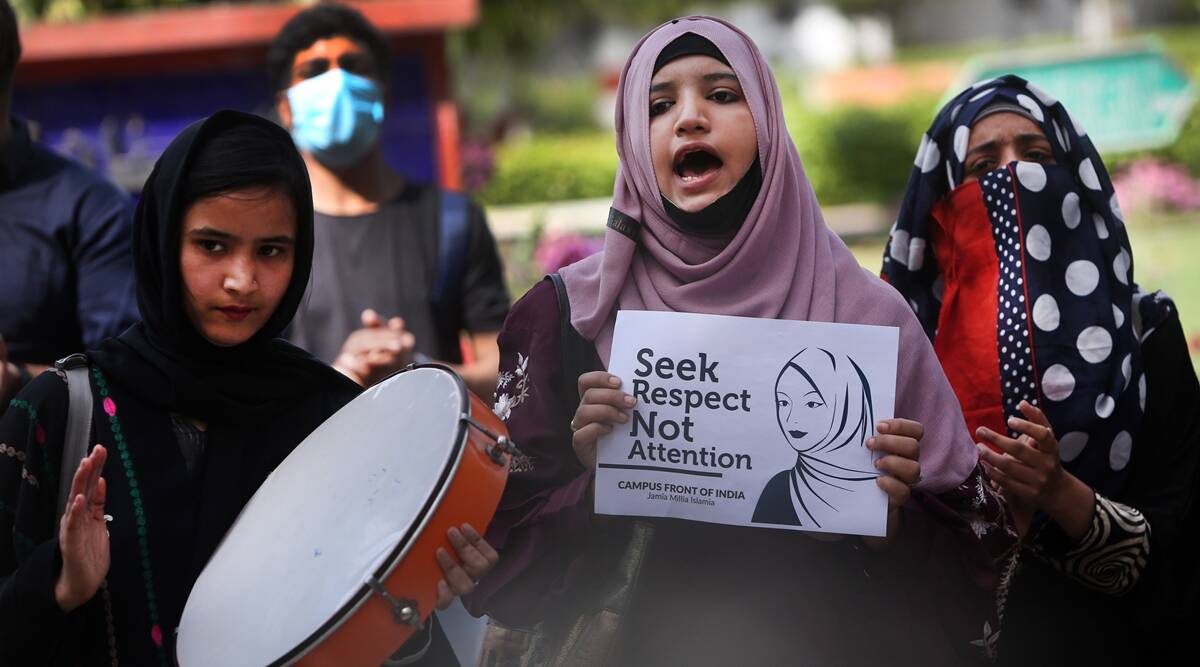Dr. Asma Lamrabet, in her article “How does the Qur’an address the issue of Muslim woman’s veil or “Hijab””, touches upon the controversial issue of the Hijab in the contemporary world; first explaining that the term does not imply to a cloth covering the hair of a Muslim woman. Then she further clarifies that the term’s semantic meaning and that of the Qur’an’s comprise a “curtain”, “separation”, or “wall”. The Qur’an’s context of the word is implied to women being protected via a materialistic separation, not specifically a piece of garment. It therefore reinforces the notions of the Hijab not being a defining mandate in the Islamic culture. Following the same path then, is the prevalent and on-going protest for demanding to wear the garment to school in
India. Since December, the spark of six Hijab-wearing females being denied to enter their school premises in Karnataka in blames of breaking uniform conduct, has gradually turned into a heated fiasco all across the nation; however, what follows is a series of speculations and inconsistencies with the storyline of this debacle.
When the females were stopped from entering their educational grounds, the young girls retaliated saying that the Hijab was a symbol of Islam, and that they had the fundamental right to protest according to India’s secular freedom. It has been answered time and time again, not just by right-wing Hindus, but by Muslims such as Dr. Lamrabet themselves that the garment does not practice authenticity or core Islamic identity for a woman and isn’t to be mistaken as a compulsion in the Qur’an. Therefore, the protests of these school-attending girls cannot be seen under the light of fighting for unbiased cultural identity. And in circumstances that it may be, the doubt of being inconsistent with this identity is what comes to mind, as the girls never came out of the dark in past years while following the same regulations.
At this point, the thought of having a choice comes upon the surface. While India, as a modern democracy does incorporate secularism and also provides individuals to practice the same, the very idea of secularism comes closer to judging things on a material surface, denouncing supernatural behaviours such as the soul. Hence, when the freedom of choice comes into play as a means to exercise secularism in religious contexts, it nullifies itself. However, the belief of choice on educational grounds brings forward the idea of discipline. Who decides if ethical beliefs are greater than the regulations of a common public premise? Academic spaces in India – Primary, secondary or senior secondary, are made to be such that they eliminate discrimination or lopsided treatments; therefore the expectations of exercising separate religious beliefs pull in a biased elitist attention. When young students come from different backgrounds based on caste, class or race, educational disciplines prohibit them to discriminate; religious practices also fall into the same sphere, which need to be kept away from interfering in a mutually respected place. Enrolment of a child in such a space then only teaches them to counter societal differences with a mind-set of acceptance. A set time of that practice every day only reinforces this disciplined idea, never taking away from their religious identity in any form.
It is noteworthy that this rebellion comes out at a specific time when it is easier for the Indian nation to sympathize and create verdicts in the headspace of misinformation. The follow-up, then, of the girls being denied of education seems like a wrongly-stated agenda, as education is the foremost concern of a young mind’s budding life, whereas the said group, without being supervised by authoritative figures, caters to exactly the opposite, by keeping the right of protesting on a higher hierarchical step. The verdict of Justice Sudhanshu Dhulia confuses the mass as the concept of education has no connection with the religious beliefs of an individual or a group. The ideation of setting up uniforms in schools comes to keep the very bias of inequality away, which does not partake in breaking its own disciplines. His statement of compromising education for the female students does not apply as an articulated understanding of the situation, as the question arises of why- why are young, school-going females not in classrooms and in courtrooms instead; and if they are minors, why aren’t responsible guardians not monitoring their preciously-wasted time.
In case of giving into the restriction of believing to be less of a Muslim if a contextually-misplaced garment isn’t allowed to be worn, one must ponder upon the wide-spread Iranian protests that are being exercised in the very removal of the context of Hijab with the Islamic woman’s identity or morality. The Iranian woman has been a bearer of repetition and habit, yet the stripping away of the Hijab does not make them feel any less of their cultural roots; how then, does it not work in favour of young women who have always been practitioners of not wearing it? The progressive belief of many Islamic nations not restricting women of hiding themselves is a sign of moving forward, which is only being turned primitive by such an ideology of the Indian Muslim.










